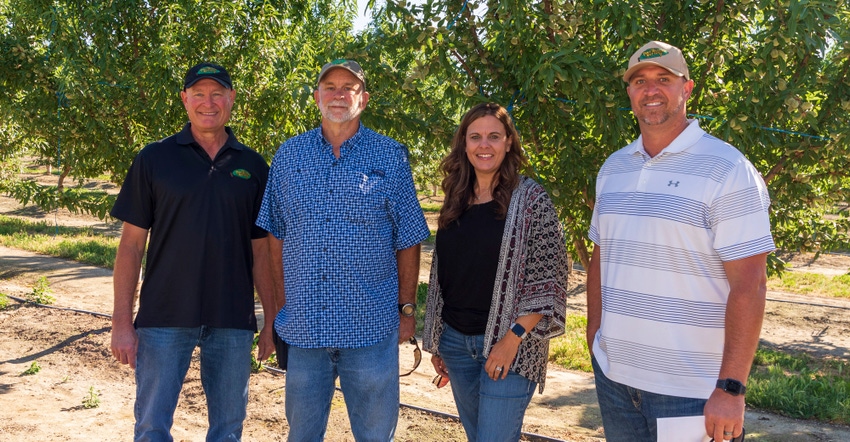
There seems to be a theme with the naming of a second self-fertile almond variety soon to be available from Dave Wilson Nursery in Modesto, Calif. In each case, the Independence variety, and the new Liberty almond seek to liberate almond growers from the need for honeybees during the late-winter pollination period.
Self-fertile almond trees are all the buzz as almond acreage soars while honeybee availability struggles to keep pace.
The Liberty almond is the latest development by Zaiger's Genetics in Modesto. The trees are marketed exclusively by Dave Wilson Nursery. Sales of the new Liberty variety almond will begin later this year as early testing and trials have shown the success of the self-fertile nut.
Grant Zaiger, the geneticist responsible for the Liberty almond tested the variety earlier this year by erecting a screen house around individual trees to check their ability to pollinate without the help of honeybees.
It worked. For the three-year-old trees in a test orchard in Modesto, the visible difference between trees that had honeybee visits, and those that were screened, are minimal.
"It does pollinate without bees and right there's the evidence of that," Zaiger said pointing to a tree he said was screened during the bloom period.
Aided by the wind
Technically speaking, the self-fertile varieties are aided in pollination by the wind, which knocks pollen from the male parts of the almond blossom onto the female parts within the same flower. Zaiger admits that while the screenhouse kept out the bees and helped prove the ability of the flowers to self-pollinate, the screens may have also limited wind effects and the nut set in the test trees somewhat.
"This seems to be a fairly vigorous tree that I think is going to be similar to Nonpareil in size," Zaiger said. The Independence was similarly marketed by Dave Wilson Nursery when it first entered the scene a few years ago.
For that reason, rootstock decisions are important, Zaiger says. His test plot of trees on the outskirts of Modesto are on Viking rootstock. He also has some trees on Nemaguard and Atlas rootstock.
Zaiger encourages growers to carefully select their rootstock to push trees to their full potential. University of California Extension researchers have information about the interaction between rootstocks and soil types common throughout the Central Valley.
"Anytime you have a variety that likes to set a lot of nuts, you need some horsepower to make them grow," he said.
Early photos of the Liberty almonds showed them to be shaped more upright than the Independence, which in its early production in commercial orchards showed them to be rounder and in need of propping up with lumber or the branches tied to support the heavier loads of almonds. Well-managed three- and four-year-old Independence almonds revealed themselves to be prolific producers. Zaiger expects similar results from the Liberty almond.
According to Zaiger, young Liberty trees were tied tightly last year and again earlier this year, making their shape more upright. "Last year they looked kind of like a wine glass," he said.
Branch angles are almost 90 degrees and as the trees mature and develop heavier nut sets "that will open it up more if you allow it," he continued. "You can shape the tree to fit your situation."
Individual leaves on the Liberty are slightly larger than the Independence. Zaiger says this will aid in capturing more sunlight.
Opening the gap in harvest timing
Zaiger's intent with the Liberty, and other yet unnamed and unreleased varieties still under study, is to open the gap in harvest timing between some of the popular varieties. For instance, the Liberty is said to harvest 10-14 days after Nonpareil almonds.
"The thing that excites us about Liberty is it's filling that niche that's outside of the Nonpareil harvest timeframe," said Jereme Fromm, vice president of sales for Dave Wilson Nursery.
Some of the unreleased varieties under study at Zaiger's seeks to move harvest timing earlier than the mainstay Nonpareil nut. Just how much earlier remains to be seen, but Zaiger says he'd like to see harvest in some of those varieties begin in early July, several weeks ahead of the traditional August start to almond harvest.
Growers interested in the Liberty almond should place their orders soon.
"Right now is the peak of our budding season," said Rachelle Antinetti, vice president of operations at Dave Wilson Nursery. "Growers interested in the Liberty or other varieties need to call the nursery right away and get those orders in."
Antinetti says the nursery is planning an early-summer field day event for growers to attend. The date and time of that event is still to be determined.
Photos of the new Liberty almond are available here.
About the Author(s)
You May Also Like






